上课用初二下册语法形容词和副词的比较级和最高级
- 格式:ppt
- 大小:2.53 MB
- 文档页数:148
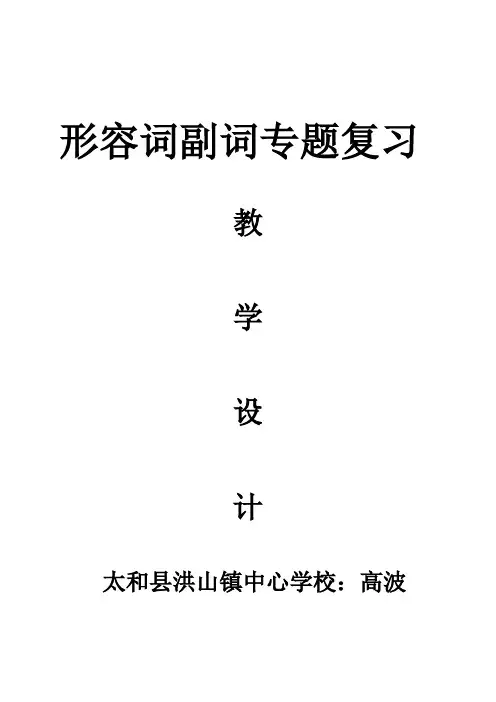
形容词副词专题复习教学设计太和县洪山镇中心学校:高波2017.5中考英语语法精讲:形容词和副词【教学目标】掌握形容词和副词的位置,基本用法和比较等级【教学内容】I. 形容词:表示人和事物的特征,对名词起修饰和描绘作用(1)形容词的位置:1.形容词在句中作定语、表语、宾语补足语等,作定语时一般放在名词前。
eg. She has short hair.(作定语)Paul is tall.(作表语)We must keep our room clean.(作宾补)2.形容词修饰不定代词时放在其后。
eg.She has something important to tell us.There’s nothing wrong in the sentence.(2)形容词作定语通常前置,但在有些情况下后置,如下表:(3)多个形容词修饰同一个名词的顺序:(4)有关形容词的重要考点:(一)形容词修饰something, anything, nothing, 或由some, any, no构成的不定代词时,把形容词后置。
1. ---Mum, Bill is coming to dinner this evening. ---OK, Let’s give him______ to eat.A. something differentB. different anythingC. anything differentD. different something2. ---Will you please tell me_____ in your city?---With pleasure. I think Wu Quan Park is worth visiting.A. interesting somewhereB. somewhere interestingC. anywhere interestingD. interesting anywhere(二)形容词作表语,放在系动词be, look, taste, smell, sound, get, become, turn, keep, seem后作表语。
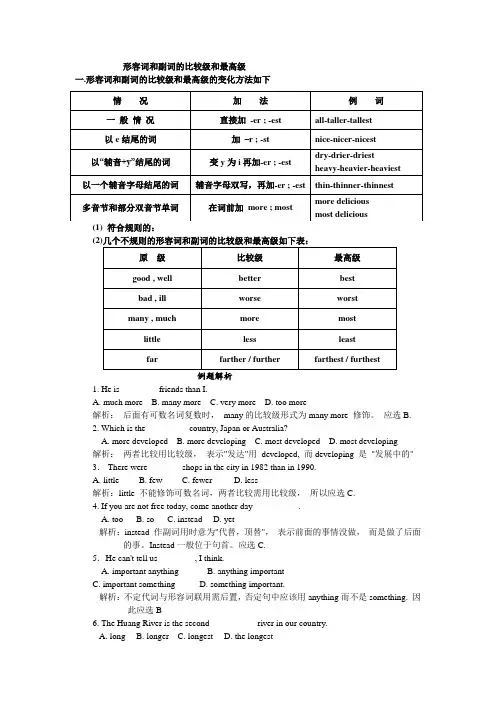
形容词和副词的比较级和最高级一.形容词和副词的比较级和最高级的变化方法如下(1) 符合规则的:例题解析1. He is ________ friends than I.A. much moreB. many moreC. very moreD. too more解析:后面有可数名词复数时,many的比较级形式为many more 修饰。
应选B.2. Which is the _________ country, Japan or Australia?A. more developedB. more developingC. most developedD. most developing解析:两者比较用比较级,表示"发达"用developed, 而developing 是"发展中的"3. There were _______ shops in the city in 1982 than in 1990.A. littleB. fewC. fewerD. less解析:little 不能修饰可数名词,两者比较需用比较级,所以应选C.4. If you are not free today, come another day __________.A. tooB. soC. insteadD. yet解析:instead 作副词用时意为"代替,顶替",表示前面的事情没做,而是做了后面的事。
Instead一般位于句首。
应选C.5.He can't tell us ________, I think.A. important anythingB. anything importantC. important somethingD. something important.解析:不定代词与形容词联用需后置,否定句中应该用anything而不是something. 因此应选B6. The Huang River is the second __________ river in our country.A. longB. longerC. longestD. the longest解析:"定冠词the+ 序数词+ 形容词最高级" 表示"第几大……" 应选C.7. The light in the office wasn't ________for him to read.A. enough brightB. bright enoughC. brightlyD. enough brightly解析:enough修饰名词时可前可后,修饰形容词或副词时,要后置。
![最全初中英语语法之形容词和副词的比较级和最高级[1]教学总结](https://uimg.taocdn.com/0ee0272aa45177232e60a20b.webp)
形容词和副词的比较级和最高级一.形容词和副词的比较级和最高级的变化方法如下(1) 符合规则的:(2)几个不规则的形容词和副词的比较级和最高级如下表:二.形容词和副词比较级的用法注意:有些形容词,如 dead, empty, round, sure, woolen 等受本身含义的限制,没有比较级。
例题解析1. He is ________ friends than I.A. much moreB. many moreC. very moreD. too more解析:后面有可数名词复数时,many的比较级形式为many more 修饰。
应选B.2. Which is the _________ country, Japan or Australia?A. more developedB. more developingC. most developedD. most developing解析:两者比较用比较级,表示"发达"用developed, 而developing 是"发展中的" 意思3. There were _______ shops in the city in 1982 than in 1990.A. littleB. fewC. fewerD. less解析:little 不能修饰可数名词,两者比较需用比较级,所以应选C.4. If you are not free today, come another day __________.A. tooB. soC. insteadD. yet解析:instead 作副词用时意为"代替,顶替",表示前面的事情没做,而是做了后面的事。
Instead一般位于句首。
应选C.5.He can't tell us ________, I think.A. important anythingB. anything importantC. important somethingD. something important.解析:不定代词与形容词联用需后置,否定句中应该用anything而不是something. 因此应选B6. The Huang River is the second __________ river in our country.A. longB. longerC. longestD. the longest解析:"定冠词the+ 序数词+ 形容词最高级" 表示"第几大……" 应选C.7. The light in the office wasn't ________for him to read.A. enough brightB. bright enoughC. brightlyD. enough brightly解析:enough修饰名词时可前可后,修饰形容词或副词时,要后置。

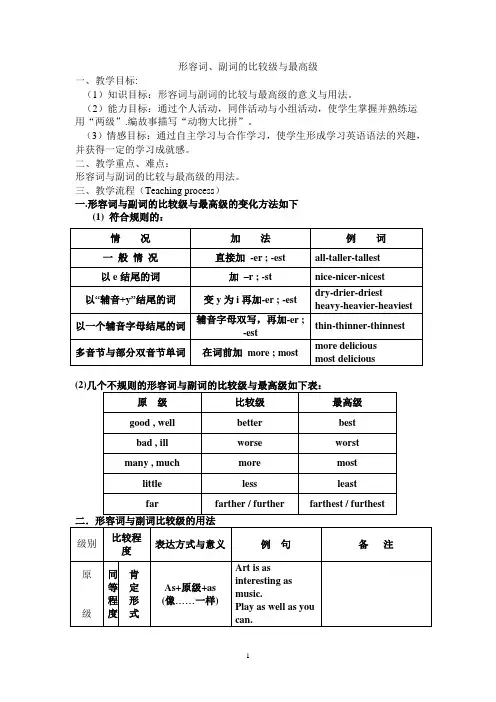
形容词、副词的比较级与最高级一、教学目标:(1)知识目标:形容词与副词的比较与最高级的意义与用法。
(2)能力目标:通过个人活动,同伴活动与小组活动,使学生掌握并熟练运用“两级”.编故事描写“动物大比拼”。
(3)情感目标:通过自主学习与合作学习,使学生形成学习英语语法的兴趣,并获得一定的学习成就感。
二、教学重点、难点:形容词与副词的比较与最高级的用法。
三、教学流程(Teaching process)一.形容词与副词的比较级与最高级的变化方法如下(1) 符合规则的:(2)注意:有些形容词,如 dead, empty, round, sure, woolen 等受本身含义的限制,没有比较级。
例题解析1. He is ________ friends than I.A. much moreB. many moreC. very moreD. too more解析:后面有可数名词复数时,many的比较级形式为many more 修饰。
应选B.2. Which is the _________ country, Japan or Australia?A. more developedB. more developingC. most developedD. most developing解析:两者比较用比较级,表示"发达"用developed, 而developing 是"发展中的" 意思3. There were _______ shops in the city in 1982 than in 1990.A. littleB. fewC. fewerD. less解析:little 不能修饰可数名词,两者比较需用比较级,所以应选C.4. If you are not free today, come another day __________.A. tooB. soC. insteadD. yet解析:instead 作副词用时意为"代替,顶替",表示前面的事情没做,而是做了后面的事。
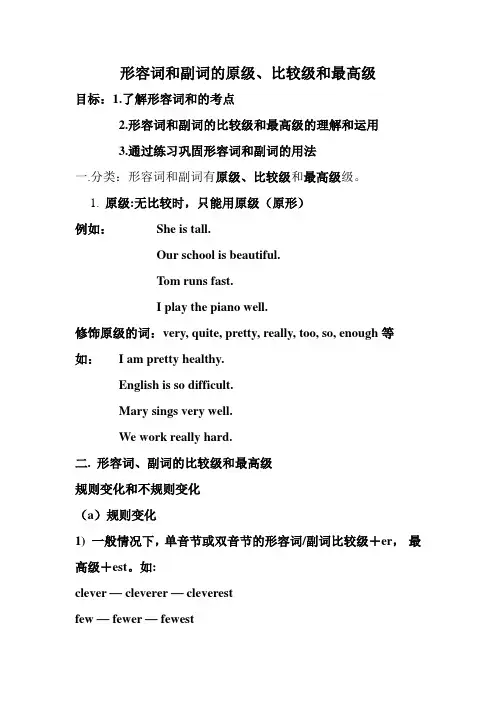
形容词和副词的原级、比较级和最高级目标:1.了解形容词和的考点2.形容词和副词的比较级和最高级的理解和运用3.通过练习巩固形容词和副词的用法一.分类:形容词和副词有原级、比较级和最高级级。
1.原级:无比较时,只能用原级(原形)例如:She is tall.Our school is beautiful.Tom runs fast.I play the piano well.修饰原级的词:very, quite, pretty, really,too, so, enough等如:I am pretty healthy.English is so difficult.Mary sings very well.We work really hard.二. 形容词、副词的比较级和最高级规则变化和不规则变化(a)规则变化1) 一般情况下,单音节或双音节的形容词/副词比较级+er,最高级+est。
如:clever — cleverer — cleverestfew — fewer — fewestsmall — smaller — smallest 等。
2) 以e结尾的词,比较级+r,最高级+st 即可。
如:nice — nicer — nicestcute — cuter — cutestlarge — larger — largest3) 以辅音字母+y结尾的变y为i+er或est如: easy — easier — easiesthappy — happier — happiest再如:early, busy, heavy, dirty, lazy 也如此。
4) 重读闭音节,单辅音结尾的,双写这个辅音字母+er 或est 的词:① fat — fatter — fattest② thin — thinner — thinnest③ hot — hotter — hottest④ red — redder — reddest⑤ wet — wetter — wettest⑥ big — bigger — biggest5) 多音节和部分双音节的词需要在形容词原级前+more 构成比较级,+the most 构成最高级。
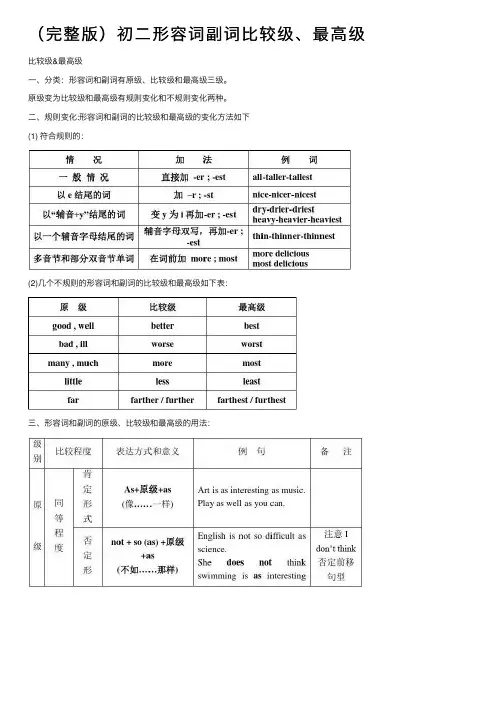
(完整版)初⼆形容词副词⽐较级、最⾼级⽐较级&最⾼级⼀、分类:形容词和副词有原级、⽐较级和最⾼级三级。
原级变为⽐较级和最⾼级有规则变化和不规则变化两种。
⼆、规则变化:形容词和副词的⽐较级和最⾼级的变化⽅法如下(1) 符合规则的:(2)⼏个不规则的形容词和副词的⽐较级和最⾼级如下表:三、形容词和副词的原级、⽐较级和最⾼级的⽤法:1e.g. This room is bigger than that one. I am taller than you.This lesson is more difficult than that one.注意:①修饰⽐较级的词有a little, a bit ,a few , a lot ,much, even,still,far,rather,any 等表程度。
e.g. Today is _________ colder than yesterday(冷得多/⼀点)②为避免重复,在从句中常⽤the one 代替可数名词单数形式,调和ones 或those代替可数名词的复数形式,that代替不可数名词。
E.g. The weather in Tianjin is colder than______of Guangzhou in winter.2、表⽰“…不如…”,⽤“less+原级+than”结构e.g. The book is less difficult than that one. The film is less interesting than that one3、不与其他事物相⽐,表⽰本⾝程度的改变,⽤“⽐较级+and+⽐较级”结构,意思是“越来越…”e.g. The weather is getting______ ______ . ______ (越来越暖和)Our country is becoming _____ ______ . ______ (越来越漂亮)4、表⽰“两者之间⽐较。
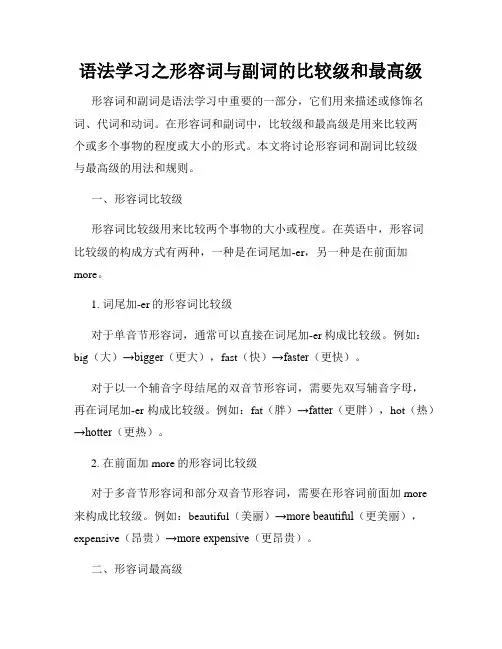
语法学习之形容词与副词的比较级和最高级形容词和副词是语法学习中重要的一部分,它们用来描述或修饰名词、代词和动词。
在形容词和副词中,比较级和最高级是用来比较两个或多个事物的程度或大小的形式。
本文将讨论形容词和副词比较级与最高级的用法和规则。
一、形容词比较级形容词比较级用来比较两个事物的大小或程度。
在英语中,形容词比较级的构成方式有两种,一种是在词尾加-er,另一种是在前面加more。
1. 词尾加-er的形容词比较级对于单音节形容词,通常可以直接在词尾加-er构成比较级。
例如:big(大)→bigger(更大),fast(快)→faster(更快)。
对于以一个辅音字母结尾的双音节形容词,需要先双写辅音字母,再在词尾加-er构成比较级。
例如:fat(胖)→fatter(更胖),hot(热)→hotter(更热)。
2. 在前面加more的形容词比较级对于多音节形容词和部分双音节形容词,需要在形容词前面加more 来构成比较级。
例如:beautiful(美丽)→more beautiful(更美丽),expensive(昂贵)→more expensive(更昂贵)。
二、形容词最高级形容词最高级用来比较三个或更多事物的大小或程度,表示最高的程度或者在一定范围内最好、最差的程度。
构成方式与形容词比较级类似。
1. 在词尾加-est的形容词最高级对于单音节形容词,通常可以在词尾加-est构成最高级。
例如:big (大)→biggest(最大),fast(快)→fastest(最快)。
对于以一个辅音字母结尾的双音节形容词,需要先双写辅音字母,再在词尾加-est构成最高级。
例如:fat(胖)→fattest(最胖),hot (热)→hottest(最热)。
2. 在前面加most的形容词最高级对于多音节形容词和部分双音节形容词,需要在形容词前面加most 来构成最高级。
例如:beautiful(美丽)→most beautiful(最美丽),expensive(昂贵)→most expensive(最昂贵)。
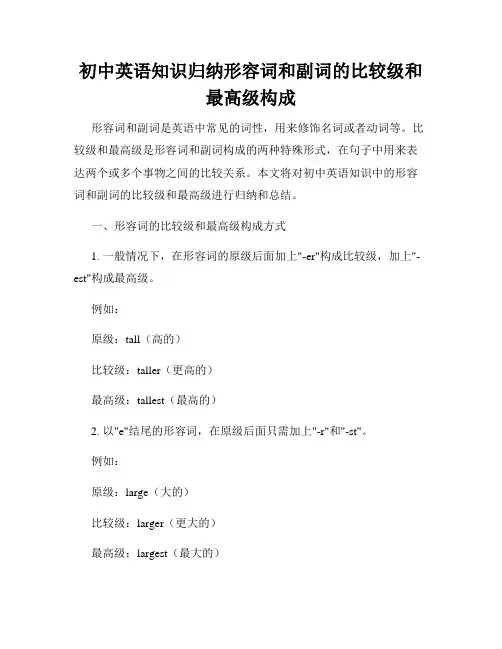
初中英语知识归纳形容词和副词的比较级和最高级构成形容词和副词是英语中常见的词性,用来修饰名词或者动词等。
比较级和最高级是形容词和副词构成的两种特殊形式,在句子中用来表达两个或多个事物之间的比较关系。
本文将对初中英语知识中的形容词和副词的比较级和最高级进行归纳和总结。
一、形容词的比较级和最高级构成方式1. 一般情况下,在形容词的原级后面加上"-er"构成比较级,加上"-est"构成最高级。
例如:原级:tall(高的)比较级:taller(更高的)最高级:tallest(最高的)2. 以"e"结尾的形容词,在原级后面只需加上"-r"和"-st"。
例如:原级:large(大的)比较级:larger(更大的)最高级:largest(最大的)3. 以辅音字母+y结尾的形容词,把"y"变为"i",再加上"-er"和"-est"。
例如:原级:happy(快乐的)比较级:happier(更快乐的)最高级:happiest(最快乐的)4. 以重读闭音节结尾,并且末尾只有一个辅音字母的形容词,要双写这个辅音字母,再加上"-er"和"-est"。
例如:原级:big(大的)比较级:bigger(更大的)最高级:biggest(最大的)5. 部分形容词的比较级和最高级是不规则的,需要特殊记忆。
例如:原级:good(好的)比较级:better(更好的)最高级:best(最好的)二、副词的比较级和最高级构成方式1. 大多数副词的比较级和最高级构成方式与形容词相同,在副词的原级后面加上"-er"和"-est"。
例如:原级:quickly(快速地)比较级:more quickly(更快地)最高级:most quickly(最快地)2. 以"e"结尾的副词,在原级后面只需加上"-r"和"-st"。